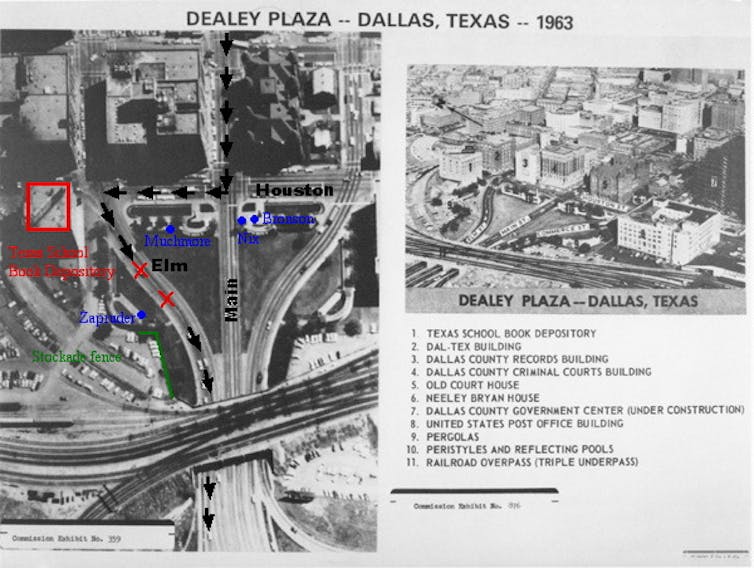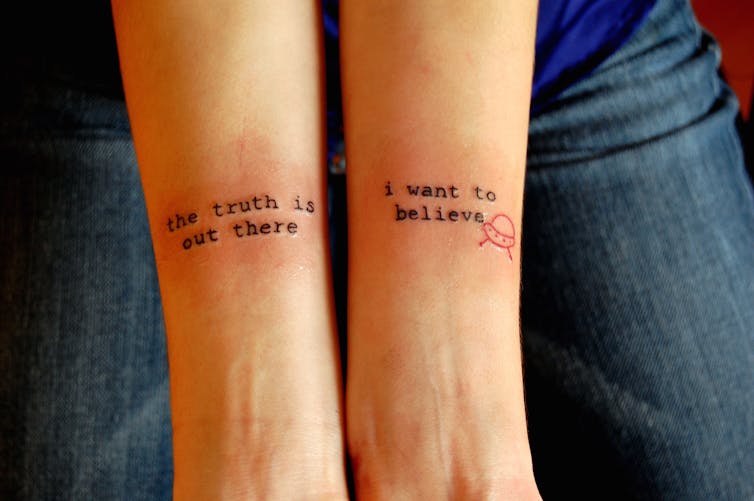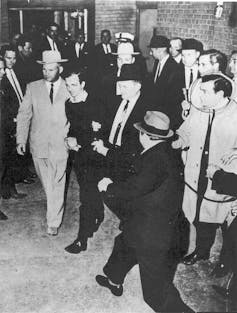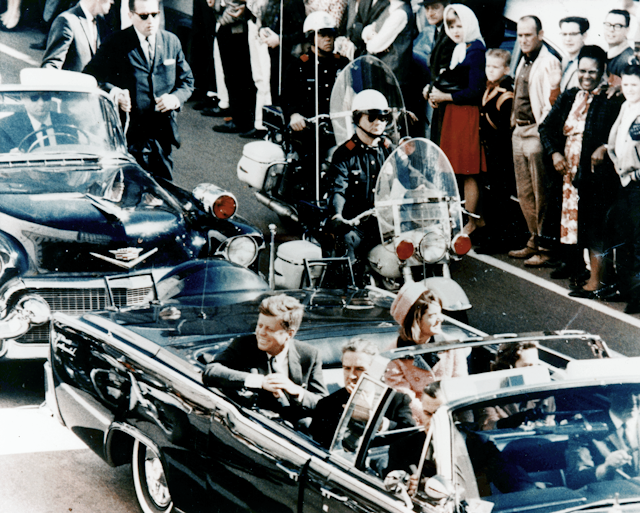This year marks 25 years since the release of Oliver Stone’s JFK (1991), starring Kevin Costner and a flamboyant supporting cast including Tommy Lee Jones, Joe Pesci, Donald Sutherland and Sissy Spacek. The three hour-plus film reignited debate over the 1963 assassination of US president John Fitzgerald Kennedy.
A quarter of a century on, that debate still festers. In addition to Stone’s fascinating (though hugely flawed) production, Kennedy’s murder has spawned countless books, films, television documentaries and websites, each devoted to solving the crime. Virtually all take a position on the shooting underpinned by one of two competing theories.
On the one hand, many commentators continue to espouse the lone gunman hypothesis, affirming the official 1964 Warren Commission finding of Lee Harvey Oswald as sole perpetrator.
The definitive document here is Vincent Bugliosi’s monumental Reclaiming History: The Assassination of President John F. Kennedy (2007), a book that runs to an astonishing 1,600 pages.
The opposing view, still widely disseminated, is that there was at least one other gunman involved. This line of reasoning, rigorously pursued in Stone’s film, by definition implies a conspiracy.

Often this burgeons to the involvement of multiple operatives. Some see the tentacles of the plot reaching all the way to Kennedy’s successor, Lyndon Johnson.
The dispute has even attracted academic research, with psychologists tracking individuals on whether they conform to the official verdict on Oswald as solitary zealot, or alternatively if they see him as the archetypal “patsy”.
The unsurprising conclusion is that the inherent polarisation of views seems destined to sustain the debate ad infinitum.
The opposition calls to mind Chris Carter’s X-Files TV series, currently enjoying a revival. Gillian Anderson’s character of Agent Scully defies stereotypical representations of women as intuitive beings by always taking a reasoned, scientific approach.

By contrast, her investigative partner Mulder (David Duchovny) prefers to explain cases in terms of complex intrigues and other-worldly phenomena.
Such stark oppositions are flawed at the outset, because they tend to downplay the actuality of humanity’s chaotic, messy existence: put simply, life is not so clear-cut. This is doubly so when attempts are made to piece together decades-past events through the blurred lens of history.
The sheer bulk of Bugliosi’s endorsement of the Warren Report and Stone’s interminable film (even longer in the subsequent “director’s cut”) evokes the famous line from Shakespeare’s Hamlet:
the lady doth protest too much, methinks.
In truth, however, the simplistic dichotomy upon which the debate is founded reveals the limitations of both positions.
It is widely assumed that if one accepts Oswald as responsible for killing the president, this means he acted alone. Using modern forensic techniques, Bugliosi and others have purportedly resolved in the affirmative the issue of whether there were only three shots, all of which came from Oswald’s antiquated rifle.
But this does not necessarily rule out the notion of a conspiracy. The desperate need to incriminate or exonerate Oswald poses a dilemma via the implementation of a narrow binary logic which bypasses other scenarios.
After all, Oswald could well have been the only gunman in a scheme executed in concert with one or more accessories.

Jack Ruby’s murder of Oswald in 1963 further suggests that the latter was far from a loner disconnected from the world around him.
Ruby’s background as an operator of sordid nightclubs, a man at the very least lurking at the fringes of organised crime, makes him a dubious candidate for a revenge killing carried out due to grief.
His involvement is perhaps the most difficult hurdle to clear for those who maintain that Oswald acted alone.
Ruby necessarily introduces a third element into the debate. A dichotomous pattern of reasoning is again disrupted by the messy business of murder.
None of this disproves Oswald’s guilt; nor does it attest to his innocence. From a distance of 50 years, Ruby’s involvement merely adds another layer to a mystery that is unlikely ever to be satisfactorily resolved.
Undeniably, many conspiracy theories involve outlandish arguments perpetuated by cranks. Those around the 2012 Sandy Hook massacre are a case in point.
Conversely, the 1970s Watergate scandal proved that complicated, government-backed conspiracies do happen. The problem with the narratives developed by Stone, Bugliosi and others is that the goal is to extinguish all doubt in a case where doubts will inevitably persist.
Thus, an arguably more convincing aesthetic representation of the Kennedy affair is the 1984 track The Motorcade Sped On cult hip-hop musician Steve “Steinski” Stein.

